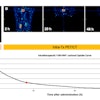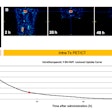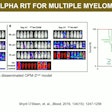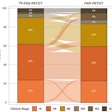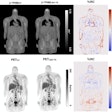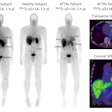An animal study shows the feasibility of an approach in colon cancer that simultaneously uses alpha- and beta-emitting isotopes to target and kill cancer cells, according to a study presented June 11 at the Society of Nuclear Medicine and Molecular Imaging (SNMMI) annual meeting.
Sara Rinne, PhD, of Weill Cornell Medicine in New York City, described a technique in mice with colon cancer xenografts that involved injecting the animals with both Actinium-225 (Ac-225) and Lutetium-177 (Lu-177) radionuclides that target a surface antigen on colon cancer cells. The technique achieved “histological cures” in the animals, she said.
“The good news was that the combination did not impair their targeting abilities,” she said.
While targeted radionuclide therapies with alpha and beta emitters – which emit ionizing radiation at different strengths – have shown great promise in cancer treatment individually, they have different physical and radiobiological properties, toxicity profiles, and suboptimal efficacy against heterogenous tumors, Rinne explained.
Thus, Rinne and colleagues have been investigating whether the use of a combined alpha- (Ac-225) and beta- (Lu-177) radioisotope therapy is feasible, with earlier lab work establishing the combined radioimmunotherapy (PRIT) approach.
In this study, the group performed serial biodistribution experiments in mice with subcutaneous GPA33-positive xenografts to determine if co-injection would alter their uptake and distribution, and to determine the injected activity needed to destroy the tumors.
They then imaged tissue samples using an ionizing-radiation quantum imaging detector (iQID), a scintillation camera that can visualize the distribution of small amounts of radiotracers within thin tissue sections.
 An autoradiography image showing the simultaneous biodistribution of Lutetium-177 and Actinium-225 radionuclides in colon cancer xenografts in mice.Image courtesy of Sara Rinne, PhD
An autoradiography image showing the simultaneous biodistribution of Lutetium-177 and Actinium-225 radionuclides in colon cancer xenografts in mice.Image courtesy of Sara Rinne, PhD
According to the findings, the autoradiography showed general overlap between Lu-177 and Ac-225 in the tumors 24 hours after co-injection, with the combination therapy as equally potent as monotherapy for inducing tumor shrinkage.
“What I really want to stress is that we did not observe any signs of toxicity. We were able to achieve histological cures without any signs of toxicity, both of which were confirmed by veterinary pathologists,” Rinne said.
Ultimately, at the study endpoint, six out of 10 mice receiving the Lu-177/Ac-225 cocktail were alive, including two mice that were clinically tumor-free, compared to five out of 10 mice in the Lu-177 monotherapy group and eight out of 10 in the Ac-225 monotherapy group, Rinne noted.
“Overall, the biggest point and what is really encouraging to us is that this combined administration was safe and effective.,” she concluded.
Click here for our full SNMMI coverage.


